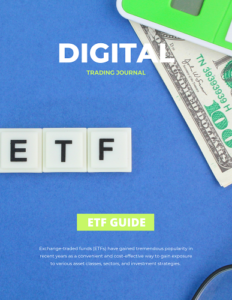
Exchange-traded funds (ETFs) have gained tremendous popularity in recent years as a convenient and cost-effective way to gain exposure to various asset classes, sectors, and investment strategies. Whether you’re a seasoned investor or just starting out in the world of trading, understanding the ins and outs of ETFs can be a game-changer for your investment portfolio. In this guide, we will delve into the exciting world of trading ETFs and explore why they have become a favored choice for many investors seeking to diversify their holdings, manage risk, and capture potential returns in the dynamic world of finance. So fasten your seatbelt, and get ready to embark on a thrilling journey into the world of trading ETFs!
How Do ETFs Work?
As an investor, you are always on the lookout for investment options that offer diversification, flexibility, and convenience. Exchange-Traded Funds (ETFs) have gained significant popularity in recent years for precisely these reasons. ETFs have revolutionized the investment landscape, providing investors with a cost-effective and efficient way to access a broad range of asset classes and investment strategies. If you’re curious about how ETFs work and how they can be a valuable addition to your investment portfolio, you’ve come to the right place. In this article, we will delve into the inner workings of ETFs, demystifying their structure, benefits, and potential risks, and empowering you with the knowledge to unlock the power of ETFs in your investment journey.
What Are ETFs? At its core, an ETF is a type of investment fund that holds a diversified portfolio of assets, such as stocks, bonds, or commodities, and is traded on stock exchanges. ETFs are designed to provide investors with exposure to a specific investment strategy, market sector, or asset class. They are similar to mutual funds in that they pool investors’ money to invest in a diversified portfolio of assets. However, ETFs are different in their structure and trading mechanism.
ETFs are created and managed by asset management companies, which issue shares of the ETF to investors. These shares are then traded on stock exchanges, allowing investors to buy or sell them throughout the trading day, just like individual stocks. The price of an ETF share is determined by the market demand and supply, and it typically reflects the underlying value of the assets held by the ETF.
How Do ETFs Work? ETFs can be structured in different ways, but the most common structure is the open-end structure. In this structure, the asset management company creates and redeems shares of the ETF on a continuous basis to meet investor demand. When an investor buys shares of an ETF, the asset management company creates new shares and sells them to the investor. Conversely, when an investor sells shares of an ETF, the asset management company redeems the shares and takes them out of circulation. This mechanism helps to ensure that the price of the ETF shares remains closely aligned with the net asset value (NAV) of the underlying assets.
ETFs can track a wide range of investment strategies, including broad market indexes, specific sectors, industries, or themes. Some ETFs may also employ active management strategies, where the asset management company actively selects and manages the assets in the portfolio in an attempt to outperform the market. However, most ETFs are passively managed and aim to replicate the performance of a particular benchmark or index.
Benefits of ETFs: ETFs offer several advantages to investors, making them a popular choice for many. Here are some key benefits of investing in ETFs:
Diversification: ETFs provide investors with instant diversification by holding a diversified portfolio of assets. This helps to spread risk and reduce the impact of individual security or sector-specific risks.
Cost-Effective: ETFs generally have lower expense ratios compared to actively managed mutual funds, making them a cost-effective investment option for long-term investors.
Liquidity: ETFs trade on stock exchanges throughout the trading day, providing investors with the flexibility to buy or sell shares at any time during market hours, offering high liquidity.
Transparency: ETFs typically disclose their holdings on a daily basis, providing investors with transparency on the underlying assets in the portfolio.
Flexibility: ETFs provide investors with the flexibility to invest in a wide range of asset classes, sectors, or investment strategies, allowing for customization and tailoring of investment portfolios to meet specific investment goals.
How many ETFs should I own as a beginner?
As a beginner investor, you may feel overwhelmed by the vast array of investment options available, including the ever-popular Exchange-Traded Funds (ETFs). ETFs offer a diversified and cost-effective way to invest in a wide range of asset classes and investment strategies. However, with so many ETFs to choose from, it’s important to strike the right balance between diversification and simplicity in your investment portfolio. In this article, we will explore the optimal number of ETFs you should own as a beginner investor, to help you navigate the world of ETF investing with confidence and clarity.
The Art of Portfolio Diversification: Diversification is a key principle of investing, aimed at spreading risk and reducing the impact of individual investment losses. ETFs are known for their ability to provide instant diversification, as they hold a diversified portfolio of assets within a single fund. However, as a beginner investor, it’s important to strike the right balance between diversification and simplicity in your portfolio.
While it may be tempting to invest in a large number of ETFs to achieve maximum diversification, it can also result in complexity and increased risk of overlapping holdings. Managing a portfolio with too many ETFs can be time-consuming and may dilute the potential returns of your investments. Therefore, it’s crucial to find the right balance between diversification and simplicity, especially as a beginner investor.
Finding the Optimal Number of ETFs: So, how many ETFs should you own as a beginner investor? There is no one-size-fits-all answer to this question, as the optimal number of ETFs in your portfolio depends on various factors, including your investment goals, risk tolerance, and time horizon. However, many financial experts recommend keeping your portfolio simple and manageable, especially for beginners.
A common rule of thumb is to aim for diversification across different asset classes, such as stocks, bonds, and commodities, while keeping the number of ETFs limited. As a beginner investor, you may start with a core portfolio of just a few ETFs that provide exposure to different asset classes. For example, you could consider a broad-based stock market ETF, a bond market ETF, and a commodity ETF. This simple portfolio can provide diversification across different asset classes and help you get started on your investment journey.
As you gain experience and confidence in your investing skills, you may consider adding a few more ETFs to your portfolio to further diversify your investments or to align with your specific investment goals or strategies. However, it’s important to be mindful of keeping your portfolio manageable and not overcomplicating it with too many ETFs.
Benefits of Simplicity: Simplicity in your investment portfolio has several benefits, especially for beginner investors:
Ease of Management: A simple portfolio with a limited number of ETFs is easier to manage and monitor, saving you time and effort in tracking multiple investments.
Clarity of Investment Strategy: A simple portfolio allows you to have a clear investment strategy and focus on your investment goals, without getting overwhelmed by too many investments.
Lower Costs: With a limited number of ETFs, you can potentially lower your overall investment costs, as you may incur fewer trading fees and management fees.
Better Risk Management: A simple portfolio can help you better manage investment risks, as you can have a clear understanding of your investments and their potential risks.
Conclusion: As a beginner investor, it’s important to strike the right balance between diversification and simplicity in your investment portfolio. While ETFs offer an excellent way to achieve diversification, it’s crucial to avoid overcomplicating your portfolio with too many ETFs.
What is the 30 day rule on ETFs?
As an investor, timing is everything. From choosing the right investment strategy to deciding when to buy or sell, making informed decisions at the right time can greatly impact your portfolio’s performance. When it comes to Exchange-Traded Funds (ETFs), a popular investment option, there’s a specific rule known as the “30-Day Rule” that investors should be aware of. In this article, we will dive into the details of the 30-Day Rule for ETFs, understanding what it is, how it works, and its implications for investors.
What is the 30-Day Rule? The 30-Day Rule, also known as the “wash sale” rule, is a regulation enforced by the Internal Revenue Service (IRS) that applies to ETFs, as well as stocks and other securities. In simple terms, the rule states that if you sell an ETF or any other security at a loss and buy a “substantially identical” security within 30 days before or after the sale, the loss may be disallowed for tax purposes.
For example, let’s say you purchased shares of an ETF and sold them at a loss. If you buy the same ETF or a similar one within 30 days of the sale, the IRS may disallow the loss as a tax deduction. This rule is in place to prevent investors from selling securities to harvest tax losses, only to repurchase them immediately, effectively avoiding paying taxes on the gains in the long run.
How Does the 30-Day Rule Work? The 30-Day Rule applies to both buying and selling of ETFs. If you sell an ETF at a loss and want to claim the loss as a tax deduction, you need to be cautious about buying a substantially identical ETF or security within the 30-day window. The IRS defines “substantially identical” as securities that are so similar that they are essentially the same investment, with only minor differences.
It’s important to note that the 30-Day Rule applies not only to purchases made after the sale but also to purchases made before the sale. If you buy a substantially identical security within 30 days before the sale, the rule still applies, and the loss may be disallowed for tax purposes.
Implications for Investors: As an investor, it’s crucial to understand the implications of the 30-Day Rule when trading ETFs. Violating the rule can have tax consequences, such as the disallowance of loss deductions, and potentially result in additional taxes owed. Therefore, it’s essential to carefully plan your ETF trading strategies to comply with the 30-Day Rule and avoid any unintended tax consequences.
Here are some key considerations for investors regarding the 30-Day Rule:
Timing your ETF Trades: If you plan to sell an ETF at a loss and want to claim the loss as a tax deduction, be mindful of the 30-day window before and after the sale. Avoid purchasing a substantially identical ETF or security within this period to comply with the rule.
Choosing Alternative Investments: If you wish to reinvest the proceeds from the sale of an ETF without violating the 30-Day Rule, consider investing in a different ETF or security that is not considered substantially identical. This way, you can still deploy your capital without triggering the rule.
Seeking Professional Advice: Tax laws and regulations can be complex, and it’s always a good idea to seek professional tax advice from a qualified tax professional or financial advisor to ensure compliance with the 30-Day Rule and other tax regulations.
Conclusion: The 30-Day Rule is an important regulation that investors need to be aware of when trading ETFs.
Are ETFs good for retirement?
As you plan for retirement, one key question that often arises is where to invest your hard-earned savings to ensure a comfortable future. With numerous investment options available, Exchange-Traded Funds (ETFs) have gained significant popularity among retirement investors in recent years. In this article, we will explore why ETFs can be a smart choice for retirement investors, highlighting their advantages and considerations for including them in your retirement portfolio.
Diversification and Risk Management: One of the key reasons why ETFs can be an attractive option for retirement investors is their inherent diversification and risk management features. ETFs are investment funds that trade on stock exchanges and typically hold a diversified basket of securities, such as stocks, bonds, or commodities. This diversification helps to spread risk across different asset classes, sectors, and geographies, reducing the impact of any one investment on the overall portfolio.
For retirement investors, diversification can be crucial in managing risk and protecting their nest egg from potential market volatility. ETFs provide a convenient way to access a diversified portfolio with a single investment, helping to minimize risk and potentially increase the stability of your retirement savings.
Low Costs: Another advantage of ETFs for retirement investors is their typically low costs compared to other investment options. ETFs are known for their passive investment approach, meaning they aim to track the performance of a specific index or benchmark, rather than trying to outperform it. This passive approach often results in lower management fees compared to actively managed funds, which can eat into investment returns over time.
Low costs can be especially important for retirement investors, as they can help to maximize the growth of your portfolio over the long term. With lower fees, more of your investment returns stay in your account, potentially allowing your retirement savings to compound more effectively.
Liquidity and Flexibility: ETFs also offer retirement investors liquidity and flexibility. Unlike traditional mutual funds, which are priced and traded at the end of the trading day, ETFs trade throughout the trading day, providing investors with the ability to buy or sell shares at any time during market hours. This liquidity can be advantageous for retirement investors who may need to make withdrawals or rebalance their portfolio as they approach retirement or during their retirement years.
Furthermore, ETFs offer flexibility in terms of investment strategies. With a wide range of ETFs available, retirement investors can choose from various asset classes, sectors, and investment themes, allowing them to customize their portfolio to their specific investment goals and risk tolerance. This flexibility can be valuable in building a diversified and well-balanced retirement portfolio that aligns with your unique retirement objectives.
Considerations for Retirement Investors: While ETFs offer several advantages for retirement investors, it’s important to consider some key factors before including them in your retirement portfolio:
Risk vs. Reward: Like any investment, ETFs come with their own risks. Market fluctuations, changes in interest rates, and geopolitical events can impact the performance of ETFs, potentially affecting your retirement savings. It’s essential to carefully assess the risk-reward tradeoff of ETFs and ensure they align with your overall retirement investment strategy.
Asset Allocation: Proper asset allocation is critical for retirement investors. While ETFs provide diversification, it’s important to ensure that your overall retirement portfolio is well-diversified across different asset classes, geographies, and sectors to manage risk effectively.
Time Horizon: Consider your time horizon when investing in ETFs for retirement. ETFs are typically a long-term investment option, and their performance may fluctuate over the short term. It’s crucial to have a long-term investment perspective and not make knee-jerk reactions based on short-term market fluctuations.
What ETF has the highest average return?
As investors seek to maximize their returns and build a diversified investment portfolio, Exchange-Traded Funds (ETFs) have emerged as a popular choice. ETFs offer a convenient and cost-effective way to gain exposure to various asset classes, sectors, and investment strategies. In this article, we will delve into the world of ETFs and explore the top performers with the highest average returns, unlocking the potential for impressive investment gains.
The Quest for High Returns: Investors are always on the lookout for investment opportunities that can generate high returns. While past performance is not indicative of future results, examining historical returns can provide insights into the performance of ETFs. Here are some ETFs that have consistently delivered high average returns:
Technology Select Sector SPDR Fund (XLK): The Technology Select Sector SPDR Fund (XLK) is one of the top-performing ETFs in recent years, focusing on the technology sector. With holdings in companies such as Apple, Microsoft, and NVIDIA, the XLK ETF has benefited from the rapid growth of the technology sector, driven by innovation and digital transformation. As technology continues to shape various industries and societies, the XLK ETF has delivered impressive average returns to investors.
ARK Innovation ETF (ARKK): The ARK Innovation ETF (ARKK) is known for its focus on disruptive and innovative companies across various sectors, including technology, health care, and genomics. Managed by ARK Investment Management, this actively managed ETF has delivered stellar average returns, capitalizing on its high-conviction investments in companies that are poised for significant growth.
iShares Russell 2000 Growth ETF (IWO): For investors seeking exposure to small-cap growth companies in the U.S., the iShares Russell 2000 Growth ETF (IWO) has been a top performer. The IWO ETF focuses on the Russell 2000 Growth Index, which includes small-cap companies with strong growth potential. Small-cap companies can offer higher growth prospects but also come with increased risks. However, the IWO ETF has delivered compelling average returns to investors who are willing to take on the additional risk.
Global X Lithium & Battery Tech ETF (LIT): The Global X Lithium & Battery Tech ETF (LIT) is a thematic ETF that focuses on companies involved in the production and use of lithium, a key component in electric vehicle batteries and energy storage. With the growing demand for electric vehicles and renewable energy, the LIT ETF has captured the attention of investors seeking exposure to this emerging industry. The LIT ETF has delivered impressive average returns, reflecting the increasing importance of lithium in the global energy landscape.
Considerations for Investors: While these ETFs have shown strong historical performance, it’s important to consider several factors when evaluating investment options:
Risk Management: ETFs, like any investment, come with risks. It’s crucial to carefully assess the risk factors associated with each ETF, including market volatility, sector-specific risks, and geopolitical risks.
Diversification: While these ETFs may offer high returns, it’s essential to ensure that your overall investment portfolio is well-diversified across different asset classes, sectors, and geographies to manage risk effectively.
Investment Goals: Consider your investment goals and risk tolerance when selecting ETFs. High-performing ETFs may come with increased risks and may not be suitable for all investors. It’s important to align your investment choices with your financial objectives and risk tolerance.












